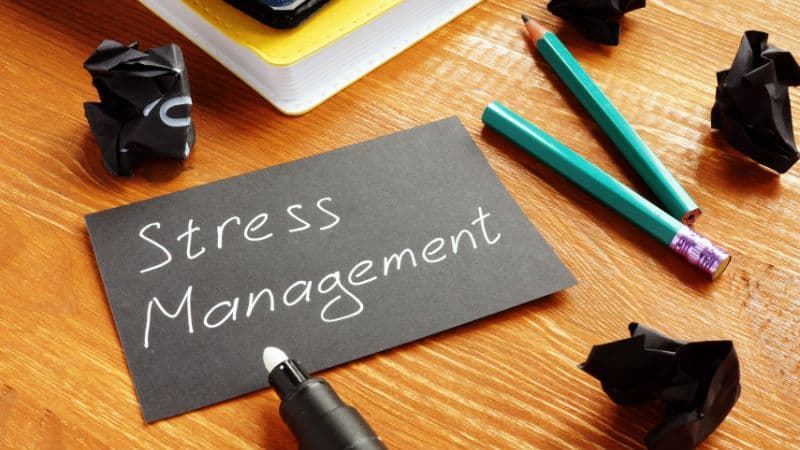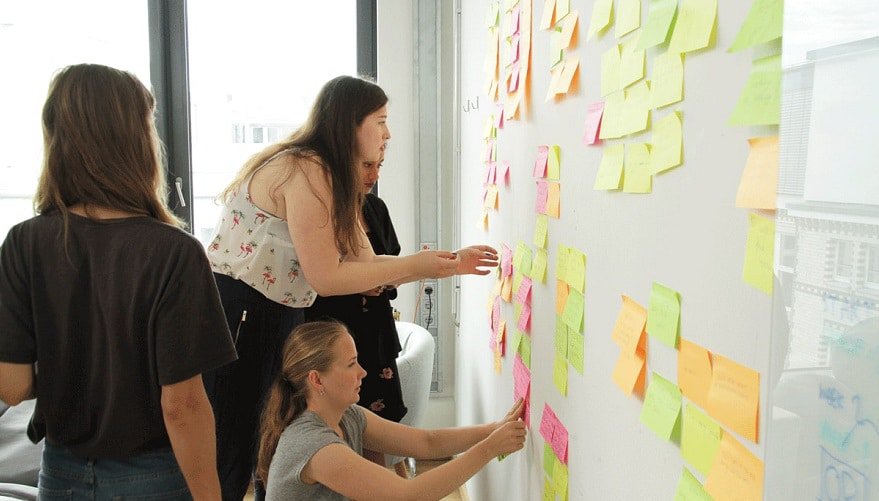Stress management refers to the techniques and strategies employed to handle and reduce stress. It involves identifying sources of stress and implementing methods to minimize its impact. Effective stress management helps in maintaining mental and physical health, improving quality of life, and enhancing the ability to cope with challenges.
Stress is like a backpack filled with rocks that gets heavier each day. We all carry it. Sometimes it’s light, sometimes it’s not.
When we can’t manage our stress, things go downhill. For professionals, too much stress is like running a marathon with no finish line. You burn out. You’re not your best at work or at home. And it’s not just about feeling bad. Stress can make you sick, tired, and less able to think straight.
In this guide, we’re diving into 25 simple, practical ways to kick stress out of your life. It’s not just about knowing what to do; it’s about understanding why it matters and how to make it happen in real life.
Let’s make that backpack lighter, step by step.
Physical Activities
Your body is like a machine. The right fuel and a good tune-up can make all the difference. That’s what Physical Activities are all about. They’re not just about getting fit or looking good. They’re about giving your mind and body a break from the stress. Think of it as hitting the reset button. In this section, we’ll explore five physical activities to help manage stress.

1. Exercise Regularly
Exercise isn’t just about lifting weights or running miles. It’s any movement that gets your heart rate up and breaks a sweat. It’s about telling your body, “Hey, we’re in this together. Let’s be strong.”
When you exercise, your body releases chemicals called endorphins. These are natural painkillers, making you feel good and reducing your perception of pain. Regular exercise keeps the stress chemicals at bay and invites the good vibes in. It’s a way of telling stress, “You’re not in charge here.”
Start small. A walk around the block. A dance party in your living room. Stretching when you wake up. Find what you enjoy and make it a habit. It’s not about being the best; it’s about being better than you were yesterday.
And remember, the best time to start was yesterday. The next best time is now.

2. Get Adequate Sleep
Sleep is your body’s time to recharge. It’s like turning off your computer when it’s slow and glitchy. When you sleep, your body fixes itself, and your mind sorts through the day’s chaos.
Without enough sleep, everything’s harder. Your brain feels foggy. Your emotions are like a rollercoaster. Stress doesn’t just knock on your door; it barges in. Good sleep is a shield against this. It helps you think clearly, stay calm, and tackle problems with a level head.
Create a sleep haven. Make your bedroom a place for sleep only – cool, dark, and quiet. Set a regular bedtime and wake-up time, even on weekends. Avoid screens and heavy meals before bed. If your mind is racing, write your thoughts down. Treat sleep like a priority, not a luxury.
3. Healthy Eating
Food is more than just fuel. It’s the building blocks for your brain and body. Eating right is like giving your body the best materials to build a strong fortress against stress.
Some foods can make stress worse, like too much caffeine or sugar. Others can help tame stress. Think of foods rich in vitamins, minerals, and antioxidants. They keep your body’s stress response in check and your brain in top shape.
Start with small changes. Add more fruits and vegetables to your meals. Choose whole grains. Drink water instead of soda. Cut down on processed foods. Listen to your body. Notice how different foods make you feel. Eating right isn’t about strict diets or being perfect. It’s about balance and making better choices one meal at a time.
4. Yoga and Meditation
Yoga and meditation are like quiet conversations with your body and mind. They’re not about twisting yourself into a pretzel or emptying your mind. It’s about awareness, balance, and finding a sense of calm.
Stress often makes us tense and scattered. Yoga helps by stretching and strengthening your body, releasing physical tension. Meditation trains your mind to focus and stay present. Together, they’re a powerful duo against stress, helping to lower blood pressure, improve mood, and enhance overall well-being.
Start with just a few minutes a day. Find a quiet spot. For yoga, do simple stretches or poses that feel good. For meditation, focus on your breath or try guided meditations available online. Be patient. It’s okay if your mind wanders or if you’re not flexible. It’s about the journey, not the destination.
5. Deep Breathing Exercises
Deep breathing is a quick, effective tool to kick stress to the curb. It’s like a mini-break for your brain and body. When you breathe deeply, it sends a message to your brain to chill out and relax.
Stress can make you breathe shallow and fast. This tells your body, “Hey, we’re in trouble.” Deep breathing does the opposite. It calms your nervous system, decreases heart rate, and lowers stress hormones. It’s a simple way to tell your body, “We’re okay.”
Try this: Sit or lie down in a comfortable spot. Put one hand on your belly, the other on your chest. Breathe in slowly through your nose, feeling your belly rise. Hold it for a second. Then breathe out slowly through your mouth, feeling your belly fall. Do this for a few minutes. Use it whenever you feel stressed, like a secret weapon in your pocket.
Psychological Strategies
The mind is a powerful thing. It can be your greatest ally or your biggest obstacle in dealing with stress. Psychological strategies are about training your mind, like a muscle, to handle stress better. It’s not about ignoring problems or pretending everything’s fine. It’s about changing how you think and react to challenges.

6. Positive Thinking
Positive thinking doesn’t mean you ignore life’s stressors. It means you approach unpleasantness more positively and productively. Think of it as looking at the glass half full instead of half empty.
Of course, if one is thirsty, it is better to drink a glass of water. Thinking is half-full won’t quench your thirst. Seriously, we need to prefer the positives.
Constant negative thinking can drag you down and amplify your stress. Positive thinking helps you cope with stress more effectively. It’s like having an inner cheerleader, encouraging you to find solutions and keep going, even when things get tough.
Start by noticing your thoughts. When you catch yourself being negative, pause. Challenge these thoughts. Is there another way to see the situation? Can you find something good, no matter how small? Practice gratitude. Each day, think of three things you’re thankful for. Shift your focus from what’s going wrong to what’s going right.
Positive thinking isn’t about ignoring reality. It’s about facing it with the right mindset. It’s a tool that can transform challenges into opportunities for growth and learning. Next, we’ll explore more psychological strategies to manage stress effectively.
Read: Choose Your Attitude

7. Time Management
Time management is like a map for your day. It helps you figure out where you’re going and how to get there efficiently. It’s not about packing as many tasks as possible into your day; it’s about prioritizing what’s important and giving yourself enough time to do it without rushing.
We can not add more hours to our day. We can only spend our hours better. I find that when I spend a few hours a day on focused work, I get more productive.
Poor time management can leave you feeling like you’re always behind, adding to your stress. Good time management gives you control. It reduces the panic of unfinished tasks and last-minute rushes. It’s about making smart choices with your time to reduce stress, not add to it.
Trust me, you will be left behind if you get to focus on the most important things. It will make you happy and healthy too.
Start by listing what you need to do and decide what’s most important. Use planners or digital tools to keep track. Set realistic deadlines. Break big tasks into smaller steps. Remember to schedule breaks and some ‘me time’. Say no to tasks that aren’t essential. Think of your time as a precious resource to be spent wisely.
8. Setting Realistic Goals
Setting realistic goals is like planting a garden. You need to know what can grow in your space and climate. Unrealistic goals are like trying to grow tropical fruits in the Arctic. They’re just going to freeze and leave you disappointed.
When I was younger, I set 10-year goals. And I was detailed. I tend to forget them after months. These days, I set my eyes on quarterly goals, monthly goals, and weekly goals.
We know what’s realistic for us.
Unrealistic goals can increase your stress because they often lead to feelings of failure and frustration. Realistic goals, on the other hand, are achievable. They give you a clear focus and a sense of accomplishment, which can reduce stress.
When setting goals, be S.M.A.R.T about it – Specific, Measurable, Achievable, Relevant, and Time-bound. Break your goals into smaller, manageable steps. Celebrate small victories along the way. Be flexible. If a goal seems out of reach, adjust it. It’s not about lowering your standards; it’s about being practical and kind to yourself.
Read the article Focus Forward: Crafting Meaningful Goals.
9. Mindfulness Practices
Mindfulness is like turning on a flashlight in a dark room. It’s about bringing your full attention to the present moment and noticing your thoughts, feelings, and surroundings without judgment. It’s not about emptying your mind; it’s about being fully aware of what’s happening right now.
Yoga helps in training yourself to mindfulness. I also found gardening an excellent exercise.
Stress often comes from worrying about the future or regretting the past. Mindfulness keeps you anchored in the present, reducing anxiety and stress. It helps you respond to situations with clarity and calmness, rather than reacting impulsively.
Start simple. Spend a few minutes each day in quiet observation. It could be focusing on your breath, eating a meal without distractions, or taking a mindful walk, noticing each step and the world around you. When your mind wanders, gently bring it back to the present. It’s a practice, so be patient with yourself.
10. Cognitive Restructuring
Cognitive restructuring is like spring cleaning for your thoughts. It’s about identifying and changing negative, unhelpful thought patterns that contribute to stress. These might be beliefs like “I must be perfect” or “I can’t handle this.”
Most of these thoughts are products of limiting beliefs and fixed mindsets. A growth mindset can help you reframe your thinking. You can focus on what’s good and what can be done.
Negative thinking is the default of many people. But adds more to the pressure.
Negative thoughts can trap you in a cycle of stress and anxiety. By changing these thoughts, you can change how you feel and react to stress. It’s about replacing irrational, unproductive thoughts with more balanced, rational ones.
Notice when you’re stuck in negative thinking. Ask yourself: Is this thought true? Is it helpful? Challenge and reframe these thoughts. Instead of thinking, “I can’t do this,” try “I can do this one step at a time.”
Write down your thoughts and the evidence for and against them. This process helps you develop a more balanced perspective.
Read: Reframe Failure
Social Connections
Humans are social creatures. We’re wired to connect with others. Social Connections focuses on the power of relationships and interactions in managing stress. It’s about building bridges, not walls, between you and the people around you.
Strong social connections can be a lifeline in the sea of stress, offering support, understanding, and a sense of belonging.

11. Seeking Social Support
Seeking social support means reaching out and connecting with others. It’s about building a network of friends, family, colleagues, or even support groups who can offer emotional and practical help during stressful times.
In my workshops, I liken social support to having to stretch 20 rubber bands instead of one. People who have social support aren’t easy to break.
When you’re stressed, it’s easy to retreat into a shell. But isolation only amplifies stress. Sharing your worries and receiving support can lighten your load. It makes problems seem more manageable. Being around others who understand and care for you can provide comfort and reduce feelings of anxiety and depression.
Start by identifying people in your life who are good listeners and positive influences. Reach out to them. It doesn’t have to be a big deal – a simple coffee date, phone call, or text can make a huge difference. Be open to talking about what you’re going through. Also, be there for them when they need support. It’s a two-way street. Remember, asking for help is not a sign of weakness; it’s a sign of strength.

12. Effective Communication
Effective communication is like building a bridge. It connects you with others, helping you express your thoughts, feelings, and needs clearly. It’s not just about talking; it’s also about listening and understanding.
I also realized that stressed individuals tend to become poor communicators.
Poor communication can lead to misunderstandings, conflicts, and increased stress. Good communication, on the other hand, helps resolve problems, build trust, and strengthen relationships. It ensures that you’re heard and understood, and it helps you to hear and understand others too.
It helps that we are always clear and intentional. And we can do that if we can keep ourselves mindful.
Practice active listening. This means really paying attention when others speak, not just planning what you’ll say next. Share your thoughts and feelings honestly but respectfully. Use “I” statements, like “I feel stressed when…” instead of “You make me stressed because…” This avoids blaming and encourages a more open, productive conversation. Remember, communication is a skill. The more you practice, the better you get at it.
13. Volunteering
Volunteering is like planting seeds in a garden. You may not see the fruits of your labor immediately, but you’re contributing to something bigger than yourself. It’s about giving your time and energy to help others, without expecting anything in return.
Helping others can give you a sense of purpose and satisfaction. It takes your mind off your own problems and puts your stresses into perspective. Volunteering connects you with others, building a sense of community and belonging. It can boost your mood, increase your self-esteem, and reduce feelings of isolation.
There is less pressure when you know that you are giving. Volunteering is a way to pay it forward. It is generosity in action.
Look for volunteering opportunities in your community. It could be at a local shelter, hospital, school, or community center. Choose something that resonates with your interests and values. Even a few hours a month can make a big difference, both to those you help and to your own well-being.
14. Building Strong Relationships
Building strong relationships is like nurturing a garden. It takes time, effort, and patience. These relationships can be with family, friends, or even colleagues. It’s about creating bonds based on trust, respect, and mutual support.
Strong relationships provide a safety net in times of stress. They offer emotional support, practical help, and a sense of belonging. Knowing you have people who care about you can make challenging times feel more manageable. It’s not just about having many connections; it’s about the quality of those connections.
Invest time and effort in your relationships. Be there for others, and don’t hesitate to let them be there for you. Communicate openly and honestly. Show appreciation and gratitude for their presence in your life. Make time for regular catch-ups, whether it’s a quick call or a coffee date.
Remember, strong relationships aren’t built overnight, but the effort you put in can bring immense rewards in terms of stress reduction and overall happiness.
15. Participating in Group Activities
Participating in group activities means getting involved in things that bring people together, like clubs, sports teams, or community projects. It’s about sharing experiences and interests with others in a group setting.
Being part of a group can give you a sense of belonging and identity. It connects you with people who share similar interests, providing a support network outside of your immediate family and friends. Engaging in group activities can be a fun and effective way to distract yourself from stress, allowing you to recharge and return to your challenges with a fresh perspective.
Explore activities in your community that align with your interests. It could be a book club, a hiking group, a dance class, or a volunteer organization. Don’t be afraid to try something new. The key is to connect with others and enjoy a shared experience.
Even if you’re shy or introverted, participating in group activities can be tailored to your comfort level, and often, the social interaction can be as rewarding as the activity itself.
Work-Life Balance
Work-life balance is like walking a tightrope. Lean too much to one side, and you might find yourself falling. It’s about finding the right balance between your professional life and personal life.
This balance is crucial for stress management. Too much work can lead to burnout, while neglecting work can lead to its own stresses. T
his category explores ways to strike that perfect balance, ensuring you’re not overstretching yourself in any one area.

16. Setting Boundaries at Work
Setting boundaries at work means clearly defining what you’re willing and able to do in your professional role. It’s about knowing when to say yes and when to say no. This helps in managing your workload and preventing work from seeping into your personal life.
Without boundaries, work can become overwhelming, eating into your personal time and increasing stress. Clear boundaries help maintain your mental health and prevent burnout. They allow you to work efficiently while also preserving time for rest and other aspects of your life.
Start by clearly defining your work hours and sticking to them. Communicate these boundaries to your colleagues and superiors. Learn to say no to tasks that exceed your capacity or aren’t part of your job responsibilities. Don’t feel guilty for not constantly being available.
Remember, setting boundaries is not just good for you; it’s good for your work as well, as it allows you to be more focused and productive during your working hours.
17. Taking Breaks
Taking breaks is like pressing the pause button in the middle of a busy day. It’s about stepping away from your work tasks for a short period. This can be a coffee break, a short walk, or just a few minutes of quiet time.
Constant work without breaks can lead to burnout and decreased productivity. Your brain needs a rest just like your body does after physical exertion. Breaks help to refresh your mind, improve concentration, and boost creativity. They’re a simple yet effective way to manage stress and prevent fatigue.
Schedule regular breaks throughout your day. Try the Pomodoro Technique: 25 minutes of focused work followed by a 5-minute break. Make sure your breaks are truly breaks – step away from your workspace, do something different, relax your mind. Avoid the temptation to check emails or do work during these times.
Use your breaks to stretch, take a walk, or do something you enjoy.
18. Workplace Organization
Workplace organization involves arranging and managing your physical and digital work environment. It’s about creating an orderly, clutter-free space and organizing your tasks and schedule.
I notice that when I am mindful of my physical clutter, I find it easier to fix my mental clutter.
A disorganized workspace can lead to increased stress and wasted time. It’s harder to focus and be productive when you’re surrounded by clutter or can’t find what you need. An organized workspace, on the other hand, can make work feel more manageable and less overwhelming.
Start by decluttering your workspace. Keep only what you need on your desk. Organize your digital files and emails for easy access. Use planners or digital tools for scheduling and keeping track of tasks.
A tidy workspace not only helps in reducing stress but also saves time and increases your efficiency at work.
19. Prioritizing Tasks
Prioritizing tasks is about deciding which tasks are most important and tackling them first. It’s like sorting your groceries; you put the perishables in the fridge first. In the work context, it means identifying which tasks have the biggest impact or are most urgent and focusing on those before moving to less critical ones.
Without prioritizing, everything seems urgent and important, leading to overwhelm and stress. By knowing what needs your attention first, you can work more efficiently, reduce the anxiety of a growing to-do list, and feel more in control of your workload.
Each day or week, make a list of tasks and rank them based on urgency and importance. Use tools like the Eisenhower Box, which divides tasks into four categories: urgent and important, important but not urgent, urgent but not important, and neither urgent nor important. Tackle the urgent and important tasks first. Learn to delegate or delay less critical tasks.
This approach not only helps in reducing stress but also ensures you’re focusing your energy where it’s most needed.
20. Work Flexibility
Work flexibility is about having control over when, where, and how you work. It’s an approach that accommodates different working styles and personal needs. This could mean flexible hours, remote work options, or the ability to adjust your schedule as needed.
Rigid work schedules and environments can add unnecessary stress, especially when they clash with personal responsibilities or preferences. Flexibility can lead to better work-life balance, reduced stress, and higher job satisfaction. It acknowledges that productivity can happen in various settings and times, not just at a desk from 9 to 5.
If possible, talk to your employer about flexible work options. Present it as a win-win, highlighting how flexibility can lead to better productivity and job satisfaction. If you’re already in a flexible work situation, manage it effectively by setting a routine that works for you, communicating clearly with your team, and ensuring you’re meeting your job responsibilities.

Leisure and Relaxation
Leisure and relaxation are like the calm after a storm. In our busy lives, it’s easy to forget the importance of taking time for ourselves. This category is all about stepping back, unwinding, and doing things that bring us joy and peace. It’s not about being lazy or unproductive; it’s about recharging our batteries so we can face our responsibilities with renewed energy and a fresh perspective.
Let’s explore ways to incorporate leisure and relaxation into our lives, reducing stress and enhancing overall well-being.
21. Hobbies and Interests
Hobbies and interests are activities you do simply because you enjoy them. They could be anything from gardening, painting, or playing a musical instrument, to bird watching or cooking. These are activities that make you lose track of time and provide a sense of fulfillment.
Engaging in hobbies and interests is a great way to break away from the stress of daily life. They provide a productive escape, giving your mind a break from your worries and allowing you to focus on something you enjoy. This can lead to increased happiness, reduced stress, and a better mood.
Identify activities that you enjoy or are curious about. It doesn’t have to be something big or expensive; it just needs to be something you find engaging and enjoyable. Allocate specific times in your week for these activities.
Remember, it’s not about being good at it; it’s about enjoying the process and giving yourself a chance to unwind and express yourself.

22. Relaxation Techniques
Relaxation techniques are specific practices designed to reduce tension in your body and calm your mind. They include methods like deep breathing exercises, progressive muscle relaxation, guided imagery, or even a simple act of soaking in a warm bath.
When stressed, your body is in a state of ‘fight or flight,’ which can be physically and mentally exhausting. Relaxation techniques help shift your body into a state of rest and recovery. They lower stress hormones, slow down your heart rate, and reduce blood pressure, promoting both physical and mental well-being.
Experiment with different relaxation techniques to find what works best for you. You might try deep breathing exercises where you focus on slow, deep breaths to calm the mind. Progressive muscle relaxation involves tensing and then relaxing different muscle groups in your body.
Guided imagery can transport you to a peaceful, serene place through visualization. Set aside a regular time each day for these practices, even if it’s just for a few minutes.
23. Travel and Vacations
Travel and vacations are about stepping out of your regular environment and routine. Whether it’s a weekend getaway, a day trip to a nearby town, or a longer holiday, travel allows you to explore new places, experiences, and cultures.
Travel provides me with opportunities to see things in a new way.
The change of scenery that comes with travel can provide a mental reset, offering new perspectives and breaking the monotony of daily life. It’s a chance to recharge, relax, and have fun. Travel can reduce stress by removing you from environments and activities that are the sources of your stress.
Plan a trip according to your interests and budget. It doesn’t have to be extravagant; even a short break to a local destination can be refreshing. Be mindful to not over-schedule activities; the goal is relaxation.
If travel isn’t possible, consider a ‘staycation’ where you take time off at home to relax and enjoy local attractions.
24. Enjoying Nature
Enjoying nature involves spending time outdoors and engaging with the natural world. This can range from a leisurely walk in the park, a hike in the woods, gardening, or simply sitting by a lake or river.
Being in nature has a soothing effect on the mind and body. It’s known as the ‘nature effect’ – it reduces stress, improves mood, and enhances mental clarity. Nature’s tranquility contrasts with the often hectic pace of modern life, offering a peaceful retreat. It can lower blood pressure, reduce cortisol levels, and boost endorphins.
Make an effort to regularly spend time in natural settings. It doesn’t require a trip to the wilderness; even urban parks or your garden can provide a natural oasis. Try to be mindful during these times – notice the sights, sounds, and smells around you.
If you’re able, engage in activities like birdwatching, hiking, or simply having a picnic. These moments of connection with nature can be incredibly restorative.

25. Creative Expression
Creative expression encompasses activities that allow you to express yourself artistically. This could include painting, writing, crafting, playing music, cooking, or even DIY home projects. It’s about using creativity as an outlet for emotions and thoughts.
Engaging in creative activities can be a powerful stress reliever. It offers a way to express yourself and process emotions in a non-verbal way. Creative expression can provide a sense of accomplishment, boost self-esteem, and offer an escape from the routine stresses of life.
Explore various creative outlets to find what resonates with you. It doesn’t matter if you’re not a professional; it’s about the process and the enjoyment it brings. Set aside regular time to engage in your chosen creative activity.
Consider joining classes or groups related to your interest for added motivation and social interaction.
Wrap Up
We’ve explored 25 ways to manage and reduce stress, grouped into five key categories: Physical Activities, Psychological Strategies, Social Connections, Work-Life Balance, and Leisure and Relaxation.
Each tip offers a unique approach to lighten the load of stress in your life. Remember, stress management is not a one-size-fits-all solution. It’s about finding what works for you and integrating these strategies into your daily routine.
As you finish reading this guide, I encourage you to try at least one of these tips. Start small, but start today. Whether it’s a short walk, a few minutes of meditation, or reaching out to an old friend, each step you take is a step towards a less stressful life.
Additionally, if you’re looking to bring more comprehensive stress management solutions to your workplace, consider my stress management workshops. Tailored to meet the unique needs of your company, these workshops provide practical tools and strategies to help employees manage stress effectively, leading to a healthier, more productive work environment.
Take the first step towards a calmer, more balanced life today. Your mind and body will thank you.
